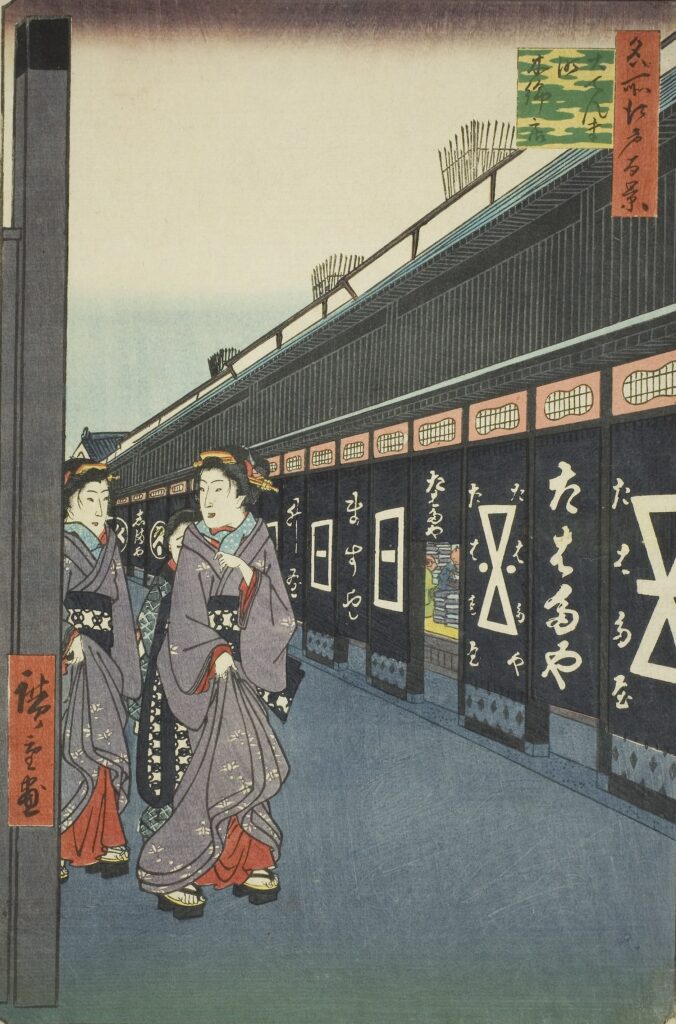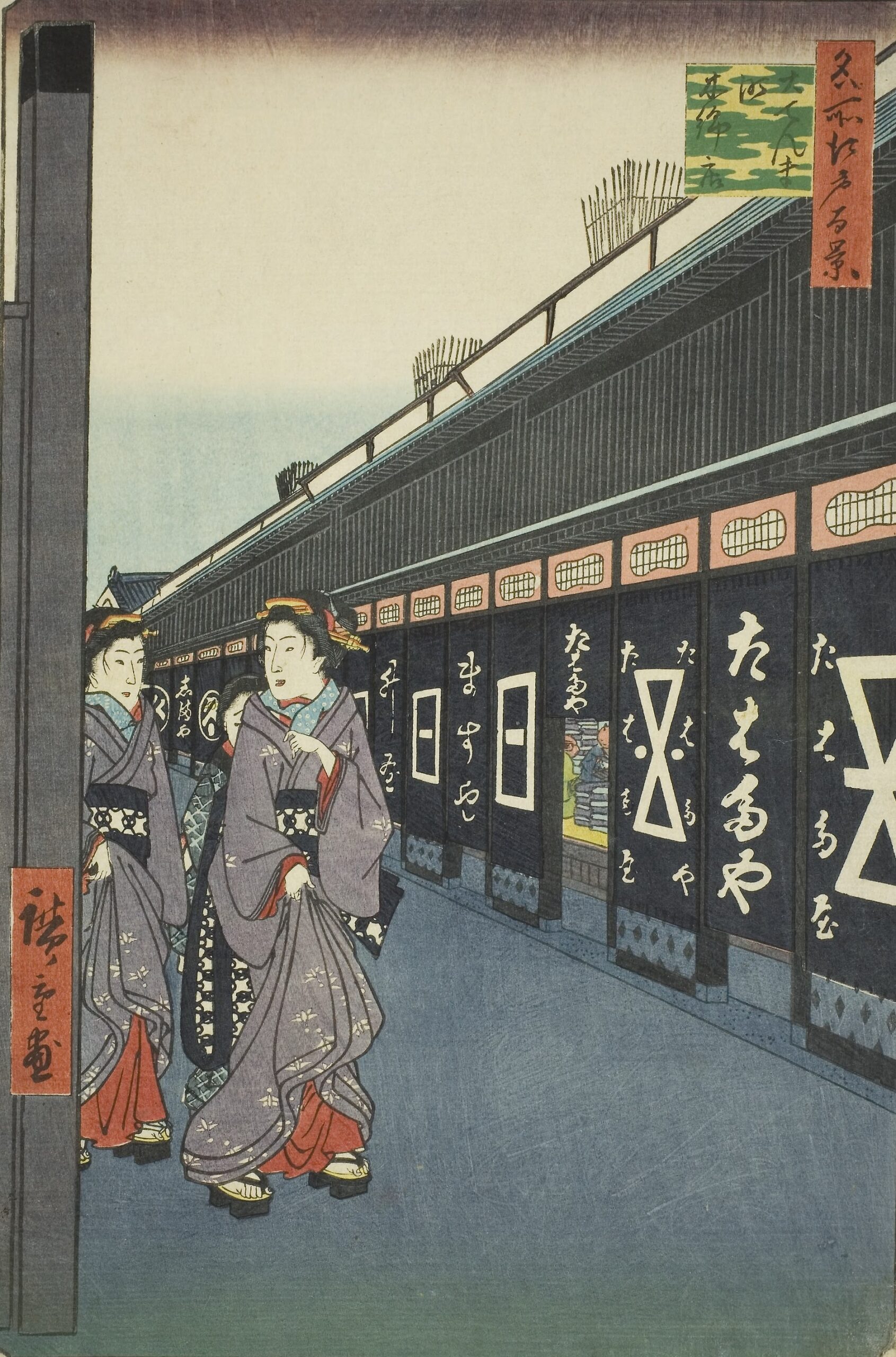
Utagawa Hiroshige – One Hundred Famous Views of Edo – 7 – Spring – Otenma-cho Cotton Shop 歌川広重-名所江戸百景-7-春-大てんま町木綿店 解説
Current Address: 2-chome, Nihonbashi-Honcho, Chuo-ku
Latitude and Longitude: Latitude 35.6890, Longitude 139.7791
Published: April 1858 Age: 62
Commentary
<1> Introduction
“Otenma-cho Cotton Shop” is a work depicting the hustle and bustle of a bustling commercial district.
It vividly depicts the scene of Otenma-cho, the center of Edo, lined with rows of cotton shops.
As a textile distribution hub that supported Edo’s economy, the area was closely connected to the clothing needs of the common people.
Hiroshige beautifully captures this bustling atmosphere through the people passing by and the majestic rows of storefronts.
<2> What is Odenmacho?
“Denma” refers to a horse used by government officials, and the word comes from the Edo shogunate’s transportation system.
During the Edo period, Odenmacho developed as a place related to logistics and the post station system.
Odenmacho was the central town and played an important role in both logistics and commerce.
From the mid- to late Edo period, Odenmacho flourished as a hub for cotton wholesalers.
Cotton transported from all over the country was traded here, and was distributed to common people throughout Edo.
Odenmacho was also a prestigious townspeople area under the shogunate, and merchants played a central role in the economy.
The townscape was well-maintained, with impressive cotton shops lining the streets.
Cotton was the main material for common people’s clothing during the Edo period.
Silk was a luxury item, while linen was used as a summer material.
Cotton was the basis for everyday wear and work clothes.
Large quantities of bolts of fabric were transported from cotton-producing regions such as Owari, Mikawa, and Ise, and distributed in Edo.
Odenmacho served as a relay point for this purpose.
The merchants of Odenmacho, who controlled the distribution of cotton, wielded such power that they dominated the Edo economy.
Fluctuation in cotton prices directly affected the lives of ordinary Edo residents, so people closely watched developments in Odenmacho.
<3> Highlights of the Painting
The painting depicts the eaves of cotton shops densely lined on both sides of the street.
Shops selling cotton bolts displayed piles of white fabric, attracting the attention of passersby.
The painting uses perspective, converging the streets of Edo toward the back, to emphasize the well-organized atmosphere of a commercial district.
This visually expresses the large scale and order of the town as a whole.
The painting also depicts shoppers gazing at the storefronts and people passing by on the streets, conveying the bustle of commerce.
The lives of Edo commoners and the dynamism of the town are condensed into this one piece.
The tenement house style, where identical shops line up under one roof, is unique to Odenmacho.
The lattices on the second floor of the buildings can be removed from the inside, and there is a rain barrel on the roof to collect rainwater.
Fire prevention equipment is also installed in case of fire.
From the right, Tabata-ya, Masuya, and Shima-ya are lined up.
Inside the light-filled shops are piles of cotton rolls.
The two people on the left, dressed in matching costumes, are geisha.
They are likely on their way home from a banquet at a wholesaler’s.
Behind them is a young attendant, her eyebrows furrowed in concern for the pair.
A large wooden door is painted on the left.
〈4〉 The appeal felt by Edo commoners
Cotton was not only a practical item, but also offered the pleasure of choosing its color, pattern, and quality.
Visiting Odenmacho felt like walking through a modern-day shopping district.
The rows of rolls of fabric lined up in front of the stores were an exciting sight to behold.
Hiroshige’s paintings also capture this “visually delightful” commercial space.
Odenmacho was known as a symbol of Edo’s wealth and a source of pride for the common people.
The mountains of cotton lined up here epitomized the richness of Edo’s consumer culture.
<5> Walking through modern-day Odenmacho
The name “Odenmacho” remains in Nihonbashi Honcho, conveying its history as a commercial hub of Edo.
Today, this area is home to many textile and clothing wholesalers, and Edo traditions continue in a modified form.
As you stroll through town, you’ll find information boards and explanations about the old Odenmacho, allowing you to imagine the Edo commercial district depicted in ukiyo-e prints.
<6> Tourist Guide
① Experience the “Edo Shopping District”
Walking through modern-day Nihonbashi Honcho with a Hiroshige ukiyo-e print in hand, you can imagine the bustling streets of yesteryear.
② Combine with sightseeing in the Nihonbashi area
There are many attractions that are an extension of Edo culture, such as Nihonbashi, Mitsukoshi Main Store, and long-established Japanese confectionery shops.
③ Learn about the current state of the textile wholesale district
The fabric and clothing wholesale business still thrives here, allowing you to experience the commercial culture that has continued since the Edo period.
④ Enjoy a stamp rally at historical sites
Walking through not only Odenmacho but also the surrounding Bakurocho and Kodenmacho areas will give you a three-dimensional understanding of the history of logistics and commerce.


